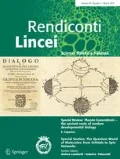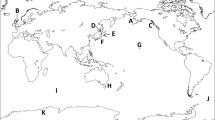Abstract
Persistent organic pollutants include several groups of chemicals with similar structures and physical–chemical properties that elicit comparable toxic effects. They have been used extensively worldwide in agriculture, industrial, and health applications. Their degradation is very slow in the polar regions due to the low temperatures and winter darkness. The aims of this study were to determine the concentrations of polychlorobyphenils (PCBs), polybromodiphenylethers (PBDEs), perfluorooctane sulfonate (PFOS), perfluorooctanoic acid (PFOA) in the Greenland sharks (Somniosus microcephalus) and other marine fishes and invertebrates from NE Greenland. The concentration increases were assessed by calculating the biomagnification factor (BMF) among pairs of alleged predator-prey organisms. PFOS were <LOD-1.28 ng/g wet wt and the PFOA ranged <LOD-14.46 ng/g wet wt. BDE47 made up most of the residue in the shark, while BDE-99 and -100 were major contributors to the ΣPBDEs in the other species of fish and invertebrates. Only PCBs 28, 52, 95, 101, 99, and 138 were found in the invertebrates and fish and their sum was higher in the Greenland shark muscle (18.26 ng/g wet wt) > Careproctus reinhardti (5.02 ng/g wet wt) > stomach content of Amblyraja hyperborea (1.4454 ng/g wet wt) > Boreogadus saida (0.355 ng/g wet wt). The higher contaminant biomagnification was found in the predator → prey pairs: shark → invertebrates (BMF_Σ6PCBs = 75-88672, BMF_Σ3PBDEs = 14-124), shark → A. hyperborea → preys, according to their diets. Ecotoxicological baseline data on marine wildlife in NE Greenland are particularly important due to the risk of prospect petroleum activities.
Similar content being viewed by others
References
Bloch ME, Schneider JG (1801) M.E. Blochii Systema Ichthyologiae iconibus ex illustratum. Post obitum auctoris opus inchoatum absolvit, correxit, interpolavit. JG Schneider, Saxo:584, pp 1–110
Campana SE, Fisk AT, Klimley AP (2015) Movements of Arctic and northwest Atlantic Greenland sharks (Somniosus microcephalus) monitored with archival satellite pop-up tags suggest long-range migrations. Deep Sea Res Part II 115:109–115. doi:10.1016/j.dsr2.2013.11.001
Christiansen JS (2012) The TUNU-programme: Euro-Arctic marine fishes-diversity and adaptation. In: di Prisco G, Verde C (eds) Adaptation and evolution in marine environments. From pole to pole vol 1. Springer, Heidelberg, pp 35–50. doi:10.1007/978-3-642-27352-0_3
Christiansen JS, Mecklenburg CW, Karamushko OV (2014) Arctic marine fishes and their fisheries in light of global change. Global Change Biol 20:352–359
Corsolini S (2009) Industrial contaminants in Antarctic biota. J Chromatogr A 1216(3):598–612
Corsolini S, Focardi S (2000) Bioconcentration of polychlorinated biphenyls in the pelagic food chain of the Ross sea. In: Faranda F, Guglielmo L, Ianora A (eds) Ross sea ecology. Springer, Heidelberg, pp 575–584
Corsolini S, Borghesi N, Schiavone A, Focardi S (2006) Polybrominated diphenyl ethers, polychlorinated dibenzo-dioxins, -furans, and -biphenyls in three species of Antarctic penguins. Environ Sci Pollut Res 14:421–429
Corsolini S, Guerranti C, Perra G, Focardi S (2008) Polybrominated diphenyl ethers, perfluorinated compounds and chlorinated pesticides in swordfish (Xiphias gladius) from the Mediterranean sea. Environ Sci Technol 42:4344–4349
Corsolini S, Ademollo N, Focardi S (2009) Bioaccumulation of chlorinated biphenyls and pesticides in Arctic fish compared to Antarctic species. In: 15th international symposium on pollutants responses in marine organisms, Bordeaux, p 262
Corsolini S, Ancora S, Bianchi N, Mariotti G, Leonzio C, Christiansen JS (2014) Organotropism of persistent organic pollutants and heavy metals in the Greenland shark Somniosus microcephalus in NE Greenland. Mar Pollut Bull 87(1–2):381–387
de Boer J, de Boer K, Boon JP (2000) In: Paasivirta J (ed) The handbook of environmental chemistry. Springer, Berlin, pp 61–95
Fisk AT, Tittlemier S, Pranschke J, Norstrom RJ (2002) Using anthropogenic contaminants and stable isotopes to assess the feeding ecology of Greenland shark. Ecology 83:2162–2172
Hansen KJ, Clemen LA, Ellefson ME, Johnson HO (2001) Compound-specific, quantitative characterization of organic fluorochemicals in biological matrices. Environ Sci Technol 35:766–767
Ikonomou MG, Rayne S, Fischer M (2002) Occurrence and congener profiles of polybrominated diphenyl ethers (PBDEs) in environmental samples from coastal British Columbia, Canada. Chemosphere 46:649–663
Kelly BC, Ikonomou MG, Blair JD, Gobas FAPC (2008) Bioaccumulation behaviour of polybrominated diphenyl ethers (PBDEs) in a Canadian Arctic marine food web. Sci Total Environ 401:60–72
Kirby RT (2008) Persistent organic pollutant accumulation in the Arctic. Sustain Dev Law Policy, Spring 8(3):31–65
Kyne PM, Sherrill-Mix SA, Burgess GH (2006) Somniosus microcephalus. In: IUCN 2013. IUCN red list of threatened species. version 2013.1. http://www.iucnredlist.org. Accessed 01 Oct 2013
Leclerc LM, Lydersen C, Haug T, Glover KA, Fisk AT, Kovacs KM (2011) Greenland sharks (Somniosus microcephalus) scavenge offal from minke (Balaenoptera acutorostrata) whaling operations in Svalbard (Norway). Polar Res 30:7342. doi:10.3402/polar.v30i0.7342
MacNeil MA, McMeans BC, Hussey NE, Vecsei P, Svavarsson J et al (2012) Biology of the Greenland shark Somniosus microcephalus. J Fish Biol 80:991–1018
McMeans BC, Svavarsson J, Dennard S, Fisk AT (2010) Diet and resource use among Greenland sharks (Somniosus microcephalus) and teleosts sampled in Icelandic waters, using δ13C, δ15N and mercury. Can J Fish Aquat Sci 67:1428–1438
Molde K, Ciesielski TM, Fisk AT, Lydersen C, Kovacs KM, Sørmo EG, Jenssen BM (2013) Associations between vitamins A and E and legacy POP levels in highly contaminated Greenland sharks (Somniosus microcephalus). Sci Total Environ 442:445–454
Nielsen J, Hedeholm RB, Simon M, Steffensen JF (2014) Distribution and feeding ecology of the Greenland shark (Somniosus microcephalus) in Greenland waters. Polar Biol 37:37–46
Pirard C, Focant JF, De Pauw E (2002) An improved clean-up strategy for simultaneous analysis of polychlorinated dibenzo-p-dioxins (PCDD), polychlorinated dibenzofurans (PCDF), and polychlorinated biphenyl (PCB) in fatty food samples. Bioanal Chem 372:373–381
Stockholm Convention (2008) http://chm.pops.int/TheConvention/ThePOPs/tabid/673/Default.aspx. Accessed 15 Nov 2015
Strid A, Jörundsdóttir H, Päpke O, Svavarsson J, Bergman Å (2007) Dioxins and PCBs in Greenland shark (Somniosus microcephalus) from the North-East Atlantic. Mar Pollut Bull 54:1514–1522
Verreault J, Skaare JU, Jenssen BM, Gabrielsen GW (2004) Effects of organochlorine contaminants on thyroid hormone levels in Arctic breeding glaucous gulls, Larus hyperboreus. Environ Health Perspect 112(5):532–537
Vorkamp K, Christensen JH, Glasius M, Rigét FF (2004) Persistent halogenated compounds in black guillemots (Cepphus grylle) from Greenland—levels, compound patterns and spatial trends. Mar Pollut Bull 48:111–121
Wania F, Mackay D (1993) Global fractionation and cold condensation of low volatility organochlorine compounds in polar-regions. Ambio 22:10–18
Yano K, Stevens JD, Compagno LJV (2007) Distribution, reproduction and feeding of the Greenland shark Somniosus (Somniosus) microcephalus, with notes on two other sleeper sharks, Somniosus (Somniosus) pacificus and Somniosus (Somniosus) antarcticus. J Fish Biol 70:374–390
Acknowledgments
The Italian National Programme of Research in Antarctica (PNRA) funded this research (Project 2009/A1.04). The samples were collected during the TUNU-IV expedition in 2010, in the framework of the international TUNU Programme. The authors are very grateful to the Colleagues and the Crew on board the R/V Jan Mayen (now Helmer Hanssen) for their kind collaboration. We are very grateful to Dr. Nicoletta Borghesi, Cristiana Guerranti and Dr. Victor Schulz-Estellano for the laboratory analyses of POP residue.
Author information
Authors and Affiliations
Corresponding author
Additional information
This peer-reviewed article is a result of the multi- and interdisciplinary research activities between the Department of Physics, Earth and Environmental Sciences of the University of Siena and the TUNU Programme led by the UiT-The Arctic University of Norway.
Electronic supplementary material
Below is the link to the electronic supplementary material.
Rights and permissions
About this article
Cite this article
Corsolini, S., Pozo, K. & Christiansen, J.S. Legacy and emergent POPs in the marine fauna of NE Greenland with special emphasis on the Greenland shark Somniosus microcephalus . Rend. Fis. Acc. Lincei 27 (Suppl 1), 201–206 (2016). https://doi.org/10.1007/s12210-016-0541-7
Received:
Accepted:
Published:
Issue Date:
DOI: https://doi.org/10.1007/s12210-016-0541-7




